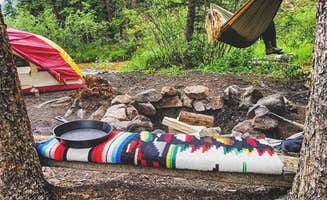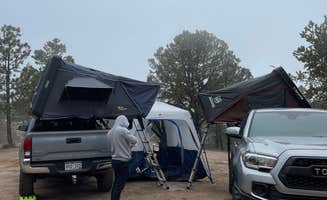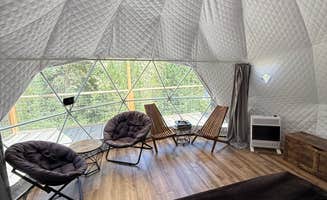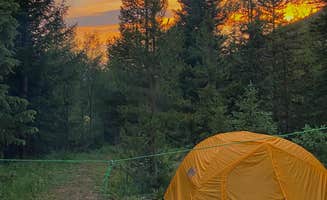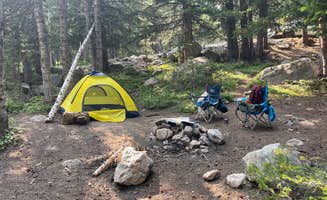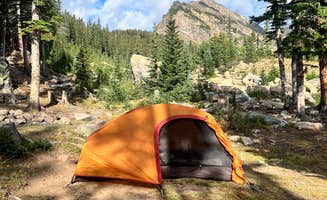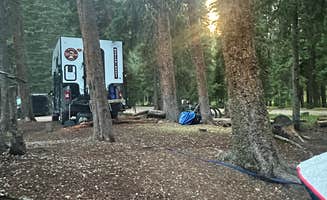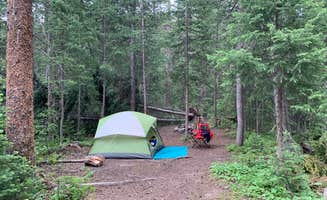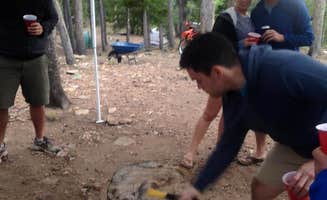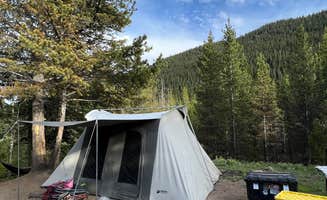Tent camping near Silver Plume, Colorado occurs at elevations typically above 9,000 feet, creating challenging conditions with extreme temperature swings between day and night. The Continental Divide runs nearby, influencing local weather patterns with afternoon thunderstorms common during summer months. Most dispersed camping locations sit within the Arapaho National Forest, requiring campers to follow specific fire regulations and adhere to the 14-day stay limit.
What to do
Fish mountain lakes and streams: Fall River Reservoir offers productive fishing opportunities with several campers reporting good catches. According to Larry S., who camped at Fall River Reservoir Dispersed Camping Trail: "Our tent was literally right next to a stream of water which was good fishing as me and my friend caught our daily limit of fish very quickly the only day we were there."
Explore abandoned mines: The area around Silver Plume features numerous historical mining structures accessible via hiking trails and forest roads. According to Daniel H. at Hidden Wilderness Roadside Camp #2: "Gorgeous campsite overlooking Idaho springs and multiple mountain ranges. I visited at the end of May '24 and the roads were all clear of snow and ice."
Mountain biking trails: Several dispersed camping areas provide direct access to mountain biking routes. A camper at Robbers Roost Campground notes: "Located just outside Winter Park, this camping area offers easy access to the Rockies while still being relatively convenient to town for supplies or activities."
What campers like
High-elevation solitude: Sites away from major roads offer significant privacy and quiet compared to established campgrounds. According to Francesca M. at Fall River Reservoir: "Such a nice escape from denver, the lake is soooo beautiful!! We showed up on a Saturday morning in July around 10 AM and still found a spot."
Crisp mountain air: The high elevations around Silver Plume provide relief from summer heat. One camper at Peru Creek Designated Dispersed Camping shared: "Great basecamp for adventures. We accessed further down the road with our mountain bikes. Once camping area had a picnic table, most others were typical dispersed camping. There is a super cool mine in the area that you can explore!"
Night sky viewing: Minimal light pollution creates exceptional stargazing opportunities at most sites. A Boreas Pass camper noted: "Site 17. Best view in my opinion. Road is fine for high clearance. But all of us with 4wD ask that you move over for us."
What you should know
Weather extremes: Tent campers should prepare for freezing overnight temperatures even during summer months. As Caite E. reports from Fall River Reservoir: "Went on a bit of a rainy weekend so it got super cold at night. The roads are super rocky as you get up to the reservoir and with the rain there were some large puddles but with the right vehicle should be all good."
Insect pressure: Many sites experience heavy mosquito activity during summer months. According to Arthur V. at Bill Moore Lake dispersed: "The first time we didn't have bug spray and had to pack up after the first night- the mosquitos were literally swarming around us. You can beat the bugs somewhat if you move away from the lake."
Road conditions: Access roads deteriorate significantly after rain or snow. One camper at Boreas Pass notes: "Easy to get to from metro Denver and it's super close to Silverthorne. Dispersed camping sites are still somewhat close together. We could definitely hear other campers around us talking and such."
Tips for camping with families
Choose lower elevation sites: Camping locations below 9,500 feet provide easier adjustment for children not accustomed to altitude. A family at The Lost Site - Dispersed Campsite shared: "Probably about a mile into the woods on very smooth dirt roads, alot of places to park."
Pack extra warm clothing: Nighttime temperatures often drop below 40°F even in summer. According to Steve B. at Fall River Reservoir: "Very buggy at night, probably because we were camping right next to a running stream. Which was amazing! Just bring lots of bug spray."
Monitor water access: Streams near camping areas may contain mining contaminants. One camper noted: "The creek water looks white from mining runoff so there isn't anything living in there from what I can tell. It looks really cool but its probably not safe."
Tips from RVers
Limited turnaround space: Many forest roads lack sufficient width for larger rigs to maneuver. According to Melanie S. at Hidden Wilderness Roadside Camp: "The road up is steep and has multiple sharp switchback turns. Got to the final turn and it was too tight for my rig and I bottomed out."
Campsite selection timing: Arrive midweek to secure prime spots for larger vehicles. A reviewer at Gordon Gulch advised: "There are fifteen 'marked' campsites. Throughout the summer they are all frequently occupied so it may be hard to find a spot at times."
Leveling challenges: Most sites feature uneven terrain requiring substantial leveling equipment. One RVer commented: "If you have a tent, depending on what sites are left, it can be very tricky to find level ground. Half the sites are on a slope."


